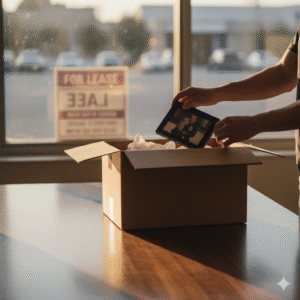How to Trademarking a Business Name in New Zealand
Your business name is more than just a name; it’s the base of your brand. It stands for your values, your reputation, and the trust you’ve built with your customers. But what if someone else starts using a name that is similar? Trademarking is a way to protect your brand identity, which is important for long-term success.
Registering your business name is an important first step, but it doesn’t mean you own it. On the other hand, a trademark protects your name legally, making sure it stays yours. This guide will show you everything you need to know about registering a business name in New Zealand, from the first search to keeping your registration up to date. We’ll talk about the costs, steps, and common mistakes to help you protect your most valuable asset.
What Is a Trademark?
A trademark is a word, logo, phrase, or even a sound that is legally protected and sets your goods or services apart from those of other businesses. The Nike “swoosh” or the golden arches of McDonald’s are good examples. These symbols are easy to recognize and are owned by the companies that use them.
The Intellectual Property Office of New Zealand (IPONZ) is in charge of registering trademarks in New Zealand. When you register a trademark, you get the only right to use, license, or sell that brand element in the country. It protects your name and logo from being used by others in a way that could confuse customers. This protection is a great way to make your brand strong and easy to spot.
Why should you trademark your business name in New Zealand?
Trademarking your business name is one of the best things you can do for your business, even though it’s not required by law. It has a lot of benefits that go beyond just having the name.
Here are the main advantages:
- Only You Have the Right: If you have a registered trademark, you are the only one who can use your business name for the goods or services you listed in your application. This stops other businesses from using a name that is similar to yours to take advantage of your success.
- The ® symbol is a strong deterrent. It lets other people know that your name is legally protected, which makes them less likely to use your brand without permission.
- Building Assets: A trademark is a type of intellectual property. You can buy, sell, or license it, which adds real value to your business. As your brand grows, so does the value of your trademark.
- Recognition of the Brand: A name that is unique and protected helps make a brand strong and well-known. Customers learn to link your trademark with quality and dependability, which builds trust and loyalty.
- Protection all over the country: A trademark is enforceable all over New Zealand, unlike a company name registration, which only protects a small area.
Can you get a trademark for your business name?
Before you start the application process, make sure your business name meets the requirements set by IPONZ. Not every name can be a trademark.
Your name must be unique and not descriptive in order to be registered. This means it shouldn’t just say what goods or services you offer. For instance, “Auckland’s Best Coffee” would probably be turned down because it is too descriptive. In contrast, “Starbucks” is distinctive and doesn’t describe coffee itself.
The main reasons for rejection are:
- Descriptive: Names that directly describe the quality, purpose, or location of the goods or services, like “Sweet Apples” or “Wellington Web Design.”
- Generic: Words that most traders would need to use, like “Chair” for a furniture store.
- Laudatory: Words that are only meant to praise, like “Best” or “Perfect.”
- Confusingly Similar: Names that are too close to existing registered trademarks.
- Offensive: Names that are likely to upset a lot of people in the community.
- Geographical Names: It’s hard to trademark names of places unless they have become unique through use.
The more creative and original your name is, the better your chances of getting it registered.
A Step-by-Step Guide to Trademarking Your Name in NZ
It may seem hard to trademark a business name, but if you break it down into smaller steps, it becomes much easier to understand. Here’s how to get around the IPONZ system.
Step 1: Do a full trademark search in New Zealand
This is the most important step. Before investing time and money in an application, you must check if your desired name—or a similar one—is already taken. A full trademark check in New Zealand can help you avoid problems and having your application turned down.
You can start by looking up the IPONZ trademark register on the web. Look for:
- Identical marks: Exactly the same name.
- Similar marks: Names that look or sound alike. .
- Phonetic equivalents: Names that are spelled differently but sound the same are called phonetic equivalents (for example, “Kwik” and “Quick”).
Don’t only look in the IPONZ database. You should also look in the Companies Office register, domain names, and general internet searches to see if another business is already using your name, even if they haven’t registered it as a trademark. Using something without registering it can still cause legal problems.
Step 2: Find out what your trademark classes are.
Trademarks are registered for specific categories of goods or services, known as trademark classes NZ. There are 45 classes in all: 34 for goods and 11 for services. You need to choose the classes that best describe what your business does.
If you sell clothes, for instance, you would apply under Class 25. If you run a cafe, you would likely apply under Class 43 (services for providing food and drink). It’s important to pick the right classes because your protection only covers the ones you sign up for. You might have to file a new application for more classes if you want to grow your business later.
Step 3: Get your application ready and send it to IPONZ.
You can start working on your application once you’ve finished your search and chosen your classes. You will need to give:
- Your name and how to get in touch with you.
- A clear representation of the trademark (the name or logo).
- A list of the goods and/or services and the classes they belong to.
You can apply online at the IPONZ website. The online system walks you through the steps and is the quickest way to apply. Make sure everything is right, because mistakes can cause delays or rejection.

What is the cost of trademarking a name in New Zealand?
The trademark cost NZ depends on the application method and the number of classes you select. IPONZ offers a pre-approved list of goods and services. You can use the “Smart Start” app, which is faster and cheaper, if you choose all of your items from this list.
- Smart Start App: The cost is lower if you use the list of terms that has already been approved. This is the recommended option for most applicants.
- Standard Online Application: The fee is higher if you have to write your own description of goods or services.
The fee for applying covers one class. There is an additional fee for each extra class you include in your application. It’s wise to budget for these costs before you begin. The question of “how much does it cost to trademark a business name?” depends entirely on the scope of your application.
What Happens After You Apply?
It’s just the start when you send in your application. It can take a few months for the whole process, from applying to registering.
The Time for the Test
Once submitted, an IPONZ examiner will review your application to ensure it meets all legal requirements. It can take anywhere from a few weeks to a few months to finish this process. The examiner looks at the name to see if it is unique and if it conflicts with any other trademarks.
If the examiner finds any problems, they will write a compliance report that lists the problems. You will have a certain amount of time, usually 12 months, to answer and fix these problems.
How long does it take to get a trademark for a business name?
The timeline can vary. If your application is straightforward with no objections, it might be accepted within 3-6 months. But if there are objections or opposition, the process could take a lot longer—maybe even more than a year.
The Time of Opposition
If your application is approved, it will be published in the IPONZ Journal. This is the start of the opposition period, which usually lasts three months. During this time, other people can challenge your trademark registration if they think it violates their rights. Your trademark will be registered if no one opposes your application or if an opposition is resolved in your favor.
Taking Care of Your Trademark
Your trademark is safe for 10 years after you apply for it.
- Renewal: You need to renew your trademark every ten years to keep it safe. IPONZ will remind you, but you are responsible for making sure the renewal fees are paid on time.
- Enforcement: You are responsible for keeping an eye on the market for any unauthorized use of your trademark. You can sue someone who is using your trademark without permission.
Things You Shouldn’t Do
There are a few things that could go wrong during the trademarking process. Avoiding these common errors can save you time, money, and stress.
- Inadequate Searching: The biggest mistake is not doing a thorough search. It could cause your application to be turned down and the fees to be wasted.
- Choosing a Descriptive Name: A lot of companies pick names that tell people what they do, but these are hard to trademark. Be creative and aim for a distinctive name.
- Incorrectly Specifying Goods/Services: If you pick a class that is too broad or too narrow, you may not be protected or get objections. Be clear about what your business does.
- Not paying attention to deadlines: There are strict deadlines for the trademark process. If you don’t respond to a compliance report by the deadline, your application may be dropped.
Take the Next Step to Keep Your Brand Safe
In New Zealand, trademarking your business name is a smart move that protects your brand’s identity and adds a lot of value to your business. The process needs a lot of attention to detail, but the long-term benefits of having exclusive ownership and legal protection are clear. You can confidently follow this guide to get registered and build a brand that will last.







